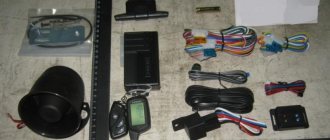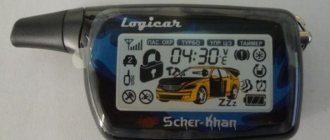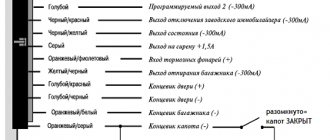The security system manufactured under the Sheriff ZX 900 brand does not have an auto-start option. However, the design of this system initially contains elements with which it is easy to implement a turbo timer. Moreover, such a timer will be compatible with any ignition switch, regardless of the number of lines switched by it. Along the way, it will be possible to block one or more power circuits, as well as connect an alarm transmitter. How to achieve all this is discussed further.
ZX-900
Installation and Use Guide.
The system has six independent (two of them are remotely controlled) functionally reprogrammable channels.
These are six physical wire lines with programmable operating logic, providing flexible changes in system functions for controlling the shutdown of turbocharged engines (turbo timer), searching for a car in a parking lot, remotely turning off the system siren in the “NIGHT” mode with a control channel for an additional pager or mobile communication device, security service a car with the engine running without an ignition key, control of additional devices at specified time intervals. The interactive pager provides real reception of signals confirming the execution of a command by the system. During one security cycle, the system provides information about each triggered sensor on the LCD display of the two-way communication key fob.
To ensure the highest level of protection for your vehicle, this security system has a programmable manual override feature. In some cases, for example, when the system's remote control key fob transmitter is lost or does not work (or perhaps your key fob transmitter is blocked by powerful radio emissions from a jammer-type device), you may need to manually arm or manually disarm the system. Read the sections “Manually arming the system” and “Manually disabling the security system,” which detail the procedures for arming and disarming the system in such a situation. In addition, this manual contains a table in one section of which the system functions are used, including the selected system shutdown method, and the optional equipment installed in the vehicle. Although the Secret Code function is not programmed by default (you must enter a personal code to disable the system), the Valet switch can also be selected to disable the system. See which method was programmed to shut down your system and review it in the appropriate section of this manual.
If the F13 “Secret Code” function is programmed, then writing codes for new key fobs, changing the secret code, changing the status of programmed functions from F12 to F27, emergency disarming of the system, turning off the system when triggered in Anti-Hi-Jack modes are possible only after entering the secret code! Changing the parameters of functions F1 to F11 does not require entering a secret code and is always available.
Standard System Features
- Super KeeLoq Pro II dynamic code.
- Separate control of security on/off modes.
- Possibility of programming up to four transmitters.
- One five-button programmable transmitter with built-in interactive pager and LCD display.
- One four-button programmable transmitter.
- Active anti-robbery transponder (additional option).
- Valet Push Button Switch.
- Sound confirmation of Valet mode.
- Two-level shock sensor.
- Small-sized siren.
- Built-in side light control relay.
- Built-in universal power output for controlling door locks.
- Control of the car's central locking in Valet mode and with the engine running.
- Three circuits of complementary interlocks (installation of an additional relay is required).
- Two connectors for connecting additional sensors (impact, volume).
- Six programmable channels for controlling vehicle service devices (additional locking, turbo timer, trigger channel, timer channel, power window control, courtesy light output, etc.).
- Two remotely controlled channels for controlling service devices.
- Security when the engine is running.
- Remote control of the siren channel in security mode (disable/enable).
- Additional (programmable) channel for controlling an external pager/actuator.
- Additional (programmable) input trigger of negative polarity.
- Manually setting the system to full security mode at any time using the Valet button, even in the absence of the ignition key.
- Silent arming and disarming of the system.
- Temporarily disable shock sensors.
- Temporarily disable the passive arming function.
- Disabling the alarm from the remote control.
- Remote control of the Panic function in all modes.
- Sound and light warning of system activation.
- Indication of alarm channels.
- Sound and light confirmation of the execution of two-way key fob commands.
- Limiting false positives.
- Limited alarm time.
- Perimeter security.
- Bypass the fault zone.
- Multifunctional LED indicator.
- Trigger memory.
- Memory of VALET, DISARM (disarmed), TRIGGERS (security input status) states when the system power is turned off.
- Immediate alarm activation when the system power is turned off/on in ARM mode (security).
- Disabling the passive engine blocking mode from the key fob transmitter.
- Control of trunk opening with temporary disabling of sensors and the hood/trunk security channel.
Programmable system functions
- Programmable immobilizer function (passive engine blocking).
- Programmable personal code for shutting down and controlling the system.
- Programmable delay for arming the system: 5/10/35 sec.
- Programmable Comfort function (close all - closing impulse of programmable duration - 10/15/22/30 sec).
- Multi-channel programmable Anti-Hi-Jack function (remote activation / when the ignition is turned on and the DOOR(+) or DOOR(-) limit switches are triggered or the vehicle starts moving).
- Programmable door lock control pulse duration: 0.5/1/3.5 sec.
- Double impulse to unlock the doors.
- Programmable re-arming function.
- Programming the central locking control mode when re-arming.
- Passive/active arming of the system.
- Programmable automatic door locking during passive arming.
- Programmable automatic door locking when the ignition is turned on.
- Programmable automatic door locking when driving.
- Programmable automatic door unlocking when the ignition is turned off.
- Output CH2 is a low-current reprogrammable controlled channel of additional devices: programmable time intervals, service pulses, control of the electric trunk drive, trigger output 1, trigger output 2.
- Output CH3 is a relay reprogrammable controlled channel of additional devices: programmable time intervals, service pulses, control of the electric trunk drive.
- Output CH4 is a low-current reprogrammable channel of additional devices: programmable time intervals, service pulses, window lift control, polite backlight output.
- Output /ARM(-) - low-current reprogrammable channel of additional devices: output of additional HP-type blocking, turbo timer.
- Output CH5 is a low-current reprogrammable channel of additional devices: an additional HP-type blocking output, a control output for a pager or other actuators.
- Output CH6 is a relay reprogrammable channel of additional devices: a “polite” backlight output, a turbo timer, a remote radio-controlled service impulse channel (remote on/off of the channel in real time using an alarm clock).
- Programmable function to disable “false” alarms of the system.
- Programmable function of pager control of the vehicle ignition mode in any system state.
Transmitters with technology to protect digital codes from interception (Keeloq)
The key fob transmitters included with this security system use the most advanced and reliable form of radio frequency transmission of any car security system currently available. Some of today's sophisticated car thieves use devices known as code grabbers, which allow them to receive and store the signal sent by the car's remote control device. After the driver leaves, this code is used by the thief to disarm the system.
Unlike the remote control devices described above, the key fob transmitters included with your security system change the code of the transmitted signal every time the button is pressed, so when a thief plays the intercepted signal from your key fob transmitter, the security system simply will not respond to it. If the button on your transmitter key fob is pressed more than 30 times when it is outside the control of the security system (for example, children are playing with it), the system will not respond to the call from the transmitter key fob when you decide to use it again. You need to synchronize your key fob transmitter with the security system receiver. To do this, simply press the system arming/disarming button on the transmitter key fob twice within one second. After this, the system will again respond to all remote control commands.
Page 5
currently car security systems.
Some of today's sophisticated car thieves use devices known as code grabbers, which allow them to receive and store the signal sent by the car's remote control device. After the driver leaves, this code is used by the thief to disarm the system.
Unlike the remote control devices described above, the key fobs-transmitters included with your security system change the code of the transmitted signal each time.
the first time the button is pressed, so when the hijacker plays back the intercepted si-
pushed your key fob transmitter, the security system simply will not respond to it. If the button on your transmitter key fob is pressed more than 30 times when it is outside the control of the security system (for example, children are playing with it), the system will not respond to the call from the transmitter key fob when you decide to use it again. You need to synchronize your key fob transmitter with the security system receiver. To do this, simply press the system arming/disarming button on the transmitter key fob twice within one second. After this, the system will again respond to all remote control commands.
Key fob transmitter buttons
Button for arming the system
(ARM)
Button for disarming the system
(DISARM)
Button for controlling the programmable channel
ch2,
controlling system modes when arming/disarming the system
Programmable channel control button ch3,
control of additional channels Button for changing the parameters of signal signals
pager, turn off the sound and light alarm of the pager
LCD display indicator combinations
3+(4) Control signal transmission (in zone/outside
5+6+7 Security mode: locking/unlocking. 8+9 Bypass the main shock sensor area. 9+10 (flashing) “Alarm triggered by strong impact” or
"arming with bypass of faulty
11 (flashing) Anti-Hi-Jack.
11 Anti-violent protection function enabled
12[flashing) “System triggered by limit switch
doors" or "arming with fault bypass
new door area."
13 Vibrate mode is turned on. 16+15(flashing) Battery full/battery low. 14 Set/cancel CH6
by timer.
14(flashing) Output CH6
is activated. 17 (flashing) Pager call. 18 Power saving mode (if the main system
disarmed, its current consumption is zero).
Valet mode enabled
— the icon is shown on the display
always while the system is in Valet mode.
24+23 Standard alarm mode. 24+25 Silent alarm/night mode.
23+24+19 (flashing) Arming when the car engine is running. 26 (flashing) “The system is activated when the ignition is turned on.” 27+21 [flashing) “Trunk/hood open” or “system triggered by the hood/hood limit switch”
garage door" or "arming by bypassing the faulty hood/trunk area."
28 (flashing) Indication of vehicle side lights. 29 Set CH6 installation time.
29 Set
the CH6 cancellation time.
Prepared by AutoSet. Car alarms and car electronics.
Specifications
Technical parameters of the product Sheriff ZX-900:
- voltage in the power supply circuit of the head unit - from 9 to 15 V;
- power consumption - up to 20 mA;
- permissible current in circuits of additional channels: 0.5-1.0 A;
- current strength in the siren line - up to 2 A;
- current in the light signaling and central locking circuits - up to 15 A;
- command transmission distance by communicator - up to 550 m;
- range of the auxiliary transmitter - up to 20 m;
- frequency range of the remote controls is 433.92 MHz.
The Sheriff communicator with 5 buttons is designed to use an AAA battery (voltage 1.5 V), which is installed in a compartment protected by a lid. The device is equipped with a unit for monitoring the degree of battery discharge; the display shows the battery status. When the charge decreases, the icon begins to blink, and then the red control diode turns on.
Equipment
The security complex was supplied to customers in the form of a set of parts packed in cardboard containers, including:
- head unit equipped with a controller and relay contact units;
- main communicator with 5 buttons and LCD screen;
- backup transmitter (with 4 keys);
- external module with antenna and status indicator;
- sensor for measuring impact force (adjustable);
- Valet switch (with separate cable);
- trunk lid contact sensor;
- a set of connecting cables with plugs and fuses;
- additional relay for blocking engine start circuits;
- technical documentation for installation and use.
Types and characteristics of models
Let's look at the most popular models of anti-theft systems among consumers:
- Sheriff with automatic start. The main feature of this anti-theft system is the ability to automatically start the car’s power unit remotely. This function is especially convenient in winter, since the driver can warm up the engine and interior of the car in advance, while at home. The “alarm” kit includes a key fob with two-way communication, which allows you to monitor the condition of the car. The cost of such anti-theft systems will be from 5 thousand rubles and more.
- Anti-theft installation Sheriff with feedback. The central processor installed in the car exchanges data with the control panel via a secure channel. As a result, the car owner will always know the condition of the car. All data on protection and impact on the body are displayed on the remote control screen. The cost of models with two-way communication averages from three thousand rubles.
- The APS-2500 model should be highlighted separately. This is a multifunctional security system equipped with a two-level sensitivity controller. It is possible to connect an additional sensor and channels for data transmission. If it is necessary to perform an emergency shutdown or activate the anti-theft system while the power unit is operating, you can use a PIN code. You can find this model on the market for 1800 rubles.
- Model ZX-750. Another alarm system with two-way communication. The main feature is that the maximum range of operation between the control module and the remote control is up to two kilometers. The anti-theft installation can monitor the operation of the light alarm. The average cost is from 4,500 rubles. The price may vary depending on the store and region where the alarm is purchased.
- BTX 5900LCD. This model belongs to the premium segment of the market and is positioned by the manufacturer as a business class alarm system. It has extensive functionality; you can configure remote engine start and automatic switching on of lights in the car interior. The average cost of the system is 6 thousand rubles.
- TX-35PRO. The system is equipped with a two-channel receiver, as well as a two-level shock controller. You can configure the device to work with four remote controls. The price of this alarm model is from 3 thousand rubles on average.
- APS-2600. The system belongs to the budget segment of the market, its average cost is about two thousand rubles. The alarm has no feedback; the kit includes two key fobs without a display. However, this alarm model allows you to effectively protect your car from burglary thanks to the included immobilizer, as well as a two-level shock sensor.
- The APS95LCD alarm has a feedback function. Signals are transmitted between the system and the remote control via a secure channel, which eliminates the possibility of impulses being intercepted by intruders. The shock controller can be adjusted to reduce or increase sensitivity. The presence of “Panic” and “Anti-grabber” modes allows you to ensure reliable system protection. The car owner can independently reprogram the anti-theft system. It is possible to automatically start the engine. This “alarm” differs from its predecessors in the design of the remote control. The cost of the alarm system is from 3 thousand rubles.
- Sheriff ZX-1070. This model of anti-theft installation is considered one of the most budget options. The package includes an upgraded remote control, and if necessary, you can configure the start of the power unit remotely. One of the varieties of this system is the Sheriff ZX-925 model. The fundamental difference is the presence of a special code intended for emergency unlocking of the system. The average cost of a car alarm is 2,500 rubles.
- ZX-900. The system is recognized as the most successful modification among the entire model range. Some market experts classify this “alarm” as a premium segment due to the large number of useful functions and capabilities. The alarm system is developed on the basis of the ZX-725 anti-theft installation. The car owner can independently program many options, including activating the lights in the car's interior. The average cost is from three thousand rubles.
Functions
Standard modes and functions supported by the equipment:
- separate keys for disarming and arming;
- support for protection mode when ignition circuits are running;
- remote change of siren channel operating parameters;
- emergency arming using the Valet switch;
- silent control mode (customizable);
- remote control of shock sensor;
- giving alarm signals by car siren and lighting equipment;
- storing the last state of the complex when the processor unit is de-energized;
- resuming alarms when power is restored;
- possibility of unlocking the trunk lock with temporary disabling of the shock sensor.
Advantages and disadvantages
The main advantages of the equipment noted by the owners:
- low cost;
- 2-way exchange of information is provided;
- additional channels for controlling external equipment.
Disadvantages of the ZX-900 budget alarm:
- interference from neighboring cars in the parking lot;
- rapid discharge of batteries in the communicator;
- outdated design, autorun support is not provided.
Table of contents
- Image
- Text
Table of contents
Standard System Features 3 Programmable System Features 4
Controlling the operation of the ZX system - 9 2 5 SHERIFF
4
Functions of the transmitter key fob buttons 4 Low battery indicator, battery replacement 6 ZX system control commands - 9 2 5 SHERIFF from the transmitter key fob 7 Programming the operating modes of the two-way communication key fob transmitter 10 Confirmation signals of the ZX system two-way communication key fob - 9 2 5 SHERIFF 11 Modes operation of the security system LED indicator 12 Siren signals 12
Operating modes of vehicle side lights 12
Additional commands for arming the system
12
Passive (automatic) arming of the system 12 Manual arming of the system 13
Car protection in security mode
13
Car protection when the security mode is on 13 Car protection when the security mode is on and the engine is running 14 Warning signals about an attempt to break into the car 14 Anti-Hi-Jack mode (protection against theft and seizure of the car)
[for all VAZ cars with an electronic speed sensor)
14
Disabling Anti-Hi-Jack mode 15 Passive engine blocking (immobilizer function F17)
15
AV FUNCTION - disarming the system in two stages 16 Active protection against car theft and hijacking in monitoring mode when
engine running (active anti-robbery transponder) - function F14 16
Disabling the system
18
Valet push-button switch 18 Valet mode (temporarily disabling the system) - on/off 19 Manually disabling the security system using the Valet switch 19 Disabling the system using a personal code 19
Additional service functions for system management
20
Additional (emergency) call from a pager 20 Automatic door locking when the ignition is turned on (function F 3 / 2) 20 Automatic door locking when the vehicle starts moving (function F 3 / 3)
(for all VAZ cars with an electronic speed sensor) 20
Automatic door locking when the vehicle's STOP pedal is pressed [function F3/4). .20 Automatic door unlocking when the ignition is turned off (function F4) 20 Remote control of additional devices (CH 2) 21 Remote control of additional devices (CH 3)
21
Remote control of additional devices (CH 4) 21 Remote control of additional devices (CH 5) 21 Remote control of additional devices (CH 6) 22 Turbo timer function .. 22 Remote control of the siren (on/off, night mode of operation of the system 22
System programming
…………………………………………………………………………….23
Programming a personal code for disabling the system 23 Programming codes for new transmitters (anti-robbery transponders) 23 Programming system functions 25
Table of programmable functions of the ZX system - 9 2 5 SHERIFF
26
2 8
System Installation Guide.
— 2 —
Prepared by AutoSet. Car alarms and car electronics.
www.AutoSet.ru
How to install
The instructions for the ZX-900 recommend adhering to the following installation sequence:
- Unpack the alarm, connect the components, and then apply power from the car battery for a preliminary test of functionality.
- Install the processor unit in the cabin, ensuring good fastening to the structural elements.
- Place switches under the trunk or hood lid that determine the position of the elements.
- Screw the sound alarm to the engine bulkhead (it is permissible to use a product with an autonomous power source).
- Stick the antenna unit onto the upper edge of the windshield.
- Lay the cable and secure the hidden switch. The unit is located in a quick access area from the driver's seat.
- Screw the shock sensor to the engine shield on the passenger side of the car. Provide unobstructed access to the part to adjust sensitivity.
- Connect the elements with the wiring harnesses supplied by the manufacturer. The connection is made in accordance with the diagrams from the documentation. The alarm system is equipped with a built-in controller that implements the central locking function.
How to remove the body of the Sheriff 5btx925lcd key fob
To disassemble the key fob you will need: a small Phillips screwdriver, a small napkin, a knife or a thin plate. To remove the remote control housing, follow the instructions.
- Turn the keychain back towards you.
- Open the battery compartment cover. Remove the battery.
- There is a self-tapping screw in the battery niche. Unscrew it.
- Using a knife or narrow plate, pry the body in the middle.
- Carefully separate the pager into two parts.
- After the work has been completed, assemble the key fob in reverse order.
User manual
The control unit of the Sheriff ZX-900 equipment is programmed based on the tables given in the operating instructions. When shipped from the factory, the setting is entered by alternating the use of the ignition and pressing the hidden Valet switch. The driver or installer can program a separate function that requires a 2-digit numeric password. The setup method and input algorithm are described in detail in the car alarm user manual.
After entering the menu, you must select the required section (by pressing the Valet button). To adjust the current value, use the button with the locked padlock symbol located on the 5BTX900LCD communicator. The adjuster performs from 1 to 5 clicks, selecting the required value from the table. After programming, it is recommended to test the operation of the complex and make adjustments (if any failures are detected).
A communicator or backup transmitter is used to control security and additional functions. The display of the main console schematically displays the state of the security zones when the protection is turned on; a separate field is allocated to display the current time. Since the screen is unified for several modifications of Sheriff alarms, some of the icons are not used.
If the remote control is lost, the driver turns on the vehicle security by pressing the Valet switch for 3 seconds. After the beep, the control diode turns on (in rapid flashing mode), which indicates that the door switches or trunk lid are waiting to close. After closing the last door, the car is armed; a regular car key is not required.
The alarm system supports an additional transponder, which is previously stored in the memory of the head unit. Additionally, adjustments must be made to the ZX-900 equipment settings. After activating the mixture ignition circuits, the search begins for a device that must be stored with the communicator. If the device is detected, the engine start circuit interlock is disabled. If the transponder is not detected, protection of the ignition and starter circuits is activated.
Why is it not programmable?
It is not always possible to program the remote control key fob Sheriff 940, 2500, 4BTX940LCD, APS95LCD B4, etc. This occurs due to incorrect operation of the system:
- the remote control is faulty;
- the alarm is constantly in the “Valet” mode, as evidenced by the red LED;
- damage to the electrical circuit running from the button to the control unit;
- The system does not recognize the “Ignition on” command. In this case, contact the service center immediately.
Find out what to do if the Alligator alarm does not respond to the key fob.
Main functions of the system
- Super Kee Loq ProII dynamic code;
- the ability to control the opening and closing of the luggage compartment by turning off the sheriff zx 900 security sensors over time;
- the car alarm has two separate channels for controlling security modes;
- disabling the engine immobilizer from the sheriff zx 900 key fob;
- simultaneous programming of two pairs of transmitters;
- Instant alarm triggering when trying to turn off system power in ARM mode;
- sheriff zx 900 main transmitter with five programmable buttons, equipped with an interactive pager and a TFT screen;
- memorization of VALET, DISARM (security system stop), TRIGGERS (security input state) modes when the supply voltage is turned off;
- main programmable transmitter with four buttons;
- remembering inclusions;
- active anti-robbery transponder (optional);
- color indicator – LED;
- Valet analog trigger;
- bypassing the breakdown site;
- sound notification about Valet mode in the alarm system;
- observation of the surrounding area and its protection;
- two-level shock sensor;
- car alarm sets the duration of the alarm period;
- small siren;
- almost complete elimination of false inclusions 58tx900lcd;
- built-in control system for vehicle signal lights;
- sound and light accompaniment of any commands transmitted by the key fob, both incoming and outgoing;
- reinforced channel for monitoring door locks;
- displaying the status of the sheriff zx 900 siren trigger channels;
- control of the main lock of the car in Valet mode, including when the engine is running;
- light and sound when the system is turned on;
- triple complementary blocking (it is necessary to install an auxiliary relay);
- control of the panic alarm function regardless of distance;
- several slots for connecting additional sensors;
- stopping the alarm signal from the remote control (key fob);
- several programmable channels for monitoring the service systems of the car (second blocking, turbo timer, trigger channel, timer channel, raising and lowering windows, etc.);
- disabling the timer security function;
- a pair of channels, with the possibility of remote control, responsible for the operation of car service systems;
- disabling shock sensors for a certain period;
- maintaining security while the engine is running;
- turning on and off the alarm without sound and light effects;
- control of the security siren while standing;
- putting the car into full security mode using the Valet key, including if there is no ignition key;
- auxiliary channel for monitoring an external pager or actuator;
- auxiliary (programmable) trigger of input type and negative polarity;
Valet Push Button Switch
The Valet key makes it possible to briefly deactivate the alarm system, so as not to hand over the remote control to a service station or parking attendant. While the alarm is in the Valet state, all security systems are turned off, except for remote control of the “Panic” mode and unlocking the door locks.
Deactivate the security system from the key fob button or Valet key, you can also do this by entering your personal code. Turn on and then turn off the ignition system. Within five seconds, press and throw the Valet key. The LED on the panel will turn on continuously. The system switched to Valet mode.
Turning off Valet mode
- Turn the ignition system on and then off.
- Within five seconds, press the Valet key.
- The LED on the panel will go off.
- The system returns to normal mode.
Alarm systems "Sheriff" have a high-quality service base, their repair will not cause difficulties for specialists, and the extensive service network will not force you to send a spare part or go to another city. Expert technicians will carry out repairs, check compatibility and quickly fix the problem. Sheriff systems are very reliable and most often repairs are simply not necessary.
The American Sheriff alarm system will reliably protect your vehicle from theft and other criminal attacks. An expanded set of functions will make driving more comfortable. The main drawback is the range of the main communicator, which in practice turns out to be less than stated.
Transmitters
ATTENTION! A completely simple way to reduce fuel consumption has been found! Don't believe me? An auto mechanic with 15 years of experience also didn’t believe it until he tried it. And now he saves 35,000 rubles a year on gasoline! Read more"
Transmitters are equipped with a technology to ensure the security of digital codes from interception attempts (Keeloq)
The key fob that the sheriff zx 900 is equipped with has the most highly protected radio channel. Many car thieves use a signal memory system that transmits a signal to the car's key fob and records it. When the driver leaves, the burglars send a code to the car and steal it. More information about this can be found in the instructions for the device.
Sheriff zx 910 works according to an algorithm that constantly changes the code. Even if the villains record the signal, the car will not respond to it. If the button on the sheriff zx 900 key fob is pressed more than thirty times (for example, children are playing with the key fob), out of sight of the car, then when you try to open the car, the transmitter will not work. In order for it to work again, it needs to be synchronized with the security system.
Protection measures
There may be an opinion that there is no protection from this device. But that's not true. It is enough to equip the car with an alarm system with dialogue encoding and the ability to turn off the standard radio channel. These requirements are met by almost all modern security devices from leading domestic manufacturers Pandora and StarLine.
Hijackers have never managed to intercept the control code of these alarms.
And you can install them in any Autostudio service. Just call and make an appointment.
Instructions for manually arming the system
If it is not possible to use the sheriff 5btx900lcd key fob, use the Valet button, it will help even if you do not have a car key.
Instructions for fully arming the vehicle:
- press briefly, quit, and then press and hold (more than 3 seconds) the VALET key until you hear a signal that the car has turned on the alarm;
- the LED will flash, signaling the closing of the last door;
- after closing the door, after three seconds the full security mode will turn on;
If there is a duplicate closing chain for the doors, and with program function F27 active (when the security system is turned on, then, according to the instructions, all doors are locked automatically), they are closed accordingly. Arming in manual mode is performed once, until the security system is turned off.
Note: if the ignition is turned off, manual arming is only possible after a pause of 5 seconds.
Autostart at time intervals or at specified temperature
If you want to configure the engine to start at certain time intervals, you need to:
- Press F twice;
- Go to the indicator flashing mode;
- After you click on the same button again, only the selected indicator will remain;
- The frequency of its flickering indicates a previously established cycle:
- No blinking indicates that the function is disabled;
- Uniform flashing – the cycle lasts an hour;
- Two flashes and a pause - a two-hour cycle;
- Three flashes and a pause - four hours;
- Four flashes and a pause - twelve hours is set.
SHERIFF CAR SECURITY SYSTEM WITH SIX SERVICES.
Sheriff, Zx-900 sheriff
CAR SECURITY SYSTEM WITH SIX SERVICES
NUMBER CHANNELS, REPROGRAMMABLE OPERATION LOGIC, BUILT-IN LCD, INTERACTIVE PAGER AND ANTI-BIGGER ACTIVE TRANSPONDER
INSTALLATION AND USE GUIDE
The system has six independent (two of them are remotely controlled) functionally reprogrammable channels. These are six physical wire lines with programmable
logic of operation, providing flexible changes in system functions to control
turning off turbocharged engines (turbo timer), searching for a car in a parking lot, dis-
stationary shutdown of the system siren in “NIGHT” mode with an additional control channel
private pager or mobile communication device, car security service with the engine running without an ignition key, control of additional devices at specified time intervals.
The interactive pager provides real reception of signals confirming the execution of a command by the system. During one security cycle, the system provides information output
about each triggered sensor on the LCD display of the two-way communication key fob.
To ensure the highest level of protection for your vehicle, this security system
The theme has a programmable manual shutdown function. In some cases, for example
when the system remote control key fob transmitter is lost or does not work (or perhaps your transmitter key fob is blocked by the device’s powerful radio emissions
"jammer" type), you may need to manually arm or manually disarm the system. Read the sections “Manually arming the system” and “Manually disabling the security system,” which detail the procedures for arming and disarming the system in such a situation. In addition, this manual contains a table in one section of which the system functions are used, including the selected shutdown method.
system, and additional equipment installed in the vehicle. Although the “Secret Code” function is not programmed by default (to disable the system, you must
you can enter a personal code), the switch can also be selected to disable the system
Valet. See what method was programmed to shut down your system,
and review it in the appropriate section of this manual.
If the F13 “Secret Code” function is programmed, then recording the codes of new key fobs, changing the secret code, changing the status of the programmed functions from F12 to F27,
emergency disarming of the system, shutdown of the system when triggered in modes
Anti-Hi-Jack is only possible after entering the secret code! Changing Function Settings
F1 to F11 does not require entering a secret code and is always available.
Prepared by AutoSet. Car alarms and car electronics.
Flashing an old 5BTX 925 LCD switch
Each action must be completed within five seconds. If you do not meet this time, the system will exit the setup mode. Start recording key fobs by turning off the anti-burglary transponder. Next, follow certain points.
- Disarm the car. Turn on the ignition.
- Click on "Jack" three times. A beep will follow.
- Press and hold the 1st key on the first remote control until you hear a long beep, confirming successful recording. The LED will flash rarely.
- Repeat the previous operation for the remaining remote devices.
- Check the transponder. The siren will sound. Turn off the switch.
- Exit setup mode by turning the ignition off or without pressing anything for eight seconds. One short and one long siren signal will sound. The LED will go out.
- Turn on the transponder.
Standard system functions.
Standard System Features
• Dynamic code Super KeeLoq Pro II.
•
Separate control of security on/off modes.
• Possibility of programming up to four transmitters. • One five-button programmable transmitter with built-in interactive pager
rom and LCD display.
• One four-button programmable transmitter. • Active anti-robbery transponder (optional) • Valet push-button switch.
• Sound confirmation of
Valet mode.
• Two-level shock sensor.
• Small-sized siren. • Built-in side light control relay. • Built-in universal power output for controlling door locks. • Control of the car's central locking in Valet
and with the engine running.
• Three circuits of complementary interlocks
(installation of an additional relay is required).
• Two connectors for connecting additional sensors (impact, volume). • Six programmable channels
for controlling vehicle service devices
(additional locking, turbo timer, trigger channel, timer channel, power window control, courtesy light output, etc.).
• Two remotely controlled channels for controlling service devices. • Security when the engine is running.
• Remote control of the siren channel in security mode (disable/enable). • Additional (programmable) channel for controlling an external pager/executor
• Additional (programmable) input trigger of negative polarity. • Manually setting the system to full security mode
at any time using the button
Valet
even without the ignition key.
• Silent arming and disarming of the system. • Temporary disabling of shock sensors. • Temporarily disable the passive arming function. • Disabling the alarm from the remote control. • Remote control of Panic
in all modes. • Sound and light warning of system activation.
• Indication of alarm channels. • Sound and light confirmation of the execution of commands from the two-way communication key fob. • Limitation of false positives. • Limited alarm time. • Perimeter security. • Bypass the fault zone. • Multifunctional LED indicator. • Trigger memory. • State memory VALET, DISARM
(disarmed),
TRIGGERS
(state of inputs
protection) when the system power is turned off.
• Immediate alarm when power is turned off/on
systems in ARM
(security).
• Disabling the passive engine blocking mode from the key fob transmitter. • Trunk opening control
with temporary shutdown of sensors and channel
Prepared by AutoSet. Car alarms and car electronics.
How to open and close a car
The main functions of the Sheriff 5BTX925LCD key fob are arming and disarming the vehicle. To set your car alarm, do the following.
- Briefly press button 1.
- A single activation of the side lights and siren will follow.
- The LED on the antenna module will begin to flash slowly.
To disarm the vehicle, click on button 2.
- The LED will go off.
- The side lights will blink twice.
- The siren will sound two times.
In addition, the following functions can be controlled from the key fob:
- turning on and off the panic mode;
- car search;
- “silent arming” and disarming;
- Anti-Hi-Jack, etc.
Hidden capabilities of the "900th Sheriff"
The security system manufactured under the Sheriff ZX 900 brand does not have an auto-start option. However, the design of this system initially contains elements with which it is easy to implement a turbo timer. Moreover, such a timer will be compatible with any ignition switch, regardless of the number of lines switched by it. Along the way, it will be possible to block one or more power circuits, as well as connect an alarm transmitter. How to achieve all this is discussed further.
Turbo timer option and “Sheriff” signaling
As stated in the instructions provided by the manufacturer, you first need to determine where contact “15/1” is located in the car. It is this contact that receives voltage when the ignition is turned on, as well as when the starter is started. The “IGN1” cord coming from the main signal connector is connected to contact “15/1”. And then, if a turbo timer will be used, connect the “IGN2” cord:
Scheme with implemented “turbo timer” optionThe switching relay, controlled by one of the programmable outputs, will close for 3 minutes (option F1). The relay coil is connected to the Disarm output, but channel CH6 can also be used.
Now see what the instructions say about programming the following two pins: CH5, Disarm. Only the second of them can control the relay, the contacts of which duplicate the turbo timer:
Alarm programming table
Channel CH6 is also provided to implement the timer. This means that it is better to leave the default values. If required, you can connect a blocking relay to the Disarm output, and a pager (alarm transmitter) is connected to wire CH5.
Basic connection diagram
The instructions supplied with the Sheriff equipment of the model in question provide a diagram:
Shown here are two latching relays: one using normally open (NO) contacts, the other using normally closed contacts. Perhaps this amount of blocking is unnecessary. But once you connect as the instructions recommend, you won’t have to program anything. The Sheriff 5btx900lcd alarm system, also known as “ZX 900”, is initially configured for the cable connection option indicated above.
To implement a turbo timer, you will need one relay, the power contacts of which can be connected to the ignition circuit. Moreover, we are talking only about the use of normally open contacts (30 and 87). This relay can be controlled by one of the following outputs:
- Programmable channel designated as CH6 (options F24 set to 2);
- Blocking output of the Sheriff ZX 900 signaling, controlling a “normally open relay” (option F22 should receive the value 2).
According to the instructions, the first option is recommended. What is better and how to connect additional equipment to the Sheriff signaling is discussed further.
Button search pattern
If a button is not found in these areas, then you need to carefully look behind the fuse hatches.
Sometimes it is located behind the glove box. The main rule during the search is not to be nervous. During binding, the alarm beeps and the car owner feels discomfort. It is not for nothing that it is said that in any situation one must include the method of deduction. In this case, you have to act like a car thief, so you need to think about what a person would do at this moment.
When the button is found, all that remains is to do everything according to the instructions.
When the key fob is attached, you can safely use it and leave the car in the parking lot.
Selecting the optimal option, programming
Let's turn to the instructions and look at the diagram, which shows what exactly the contacts of the additional relay should close:
The Sheriff ZX 900 signaling system has a turbo timer initially. The duration of its operation is regulated by option F1. Wires IGN1 and IGN2, shown in the diagram, must be included in the car's ignition wire. The IGN1 cord, when connected to a standard lock, is connected to terminal “15” (not shown in the diagram). It turns out that it remains to consider what the winding of your relay should be connected to. Which is done in the next chapter.
Connecting the turbo timer relay coil
Let's say you have a 30 amp normally open relay and need to implement a turbo timer. Then, when choosing a control output to connect the relay coil, follow the algorithm:
- If both a pager and a lock are used, one channel can control the behavior of the turbo timer relay - CH6 (set option F24);
- If blocking is not needed, it is better to connect the winding to a black wire with a white stripe (program option F22);
- Even when using blocking, you can do as indicated in point “2”, but then the blocking relay is connected to the “gray” wire (CH5).
Note that the Sheriff 5btx900lcd alarm system is initially configured as follows: output CH5 must control another blocking relay (N.R.). To control the pager, configure option F22.
The wiring diagrams for the winding contacts look simple:
These diagrams are not included in the instructions, but they are generally accepted. Everything that applies to electrical equipment is also true for Sheriff signals. Use the circuits by installing any low-current diode. The voltage value on it does not exceed 16 Volts.
When installing or switching any wires in the car, be sure to disconnect the negative terminal of the battery. This advice is also well known.
Signal programming
Having opened the instructions, you can immediately find a table of programmable options:
If function F13 is still assigned the value “code”, programming the Sheriff ZX 900 system is done as follows:
- You need to disable the security mode and turn on the ignition;
- The Valet button is pressed a certain number of times equal to the first digit of the code;
- The ignition is turned off and on again;
- Repeat “step 2” for the second value;
- The ignition is turned off and on, then proceed to “step 3” from the previous sequence.
Pay attention to the important options: duration of the turbo timer (F1), assignment of the INST2 input (F16) and everything that is indicated in the text. It is clear that service functions are indicated by numbers whose value exceeds “13”. And everything that is less than 13 is user options, and nothing more.
Note that by turning off the ignition, the owner can interrupt the operation of the turbo timer at any time. To do this, press the “3” key on the key fob twice.
Programming a new key fob pager
If you intend to record the code of the anti-robbery transponder, then turn off its power before starting any action. In order to attach the key fob to the alarm control unit, disarm the car using a command from the remote control or by entering the code using the “Valet” button. When using a secret password, the pager is linked using the following algorithm.
- Turn the ignition on and off. Turn it on again.
- By pressing the “Valet” key, enter the first digit of the personal code (the number of presses is the first value of the password).
- Turn the ignition off and on.
- Using the "Jack" key, enter the second code value.
- Deactivate and activate the ignition. A beep will follow.
- Click "Jack" three times. There will be one long beep of the siren.
- Press the 1st button of the first switch. A squeak will follow.
- Repeat the previous step for the remaining remote controls.
- Turn on the transponder. A siren will sound indicating successful actions. Turn off your device.
- To exit programming mode, turn off the ignition or do nothing for eight seconds. One short and one long beep will sound. The LED indicator will turn off.
- Check the transponder.
Possible problems and their solutions
If the equipment does not respond to the key fob, then you need to check the condition of the battery. The cause of the defect may be destruction of the key mechanisms or failure of the communicator controller due to moisture. To determine the cause of the breakdown, you need to disassemble the device; in case of irreversible damage, you will need to purchase a new remote control.
To disassemble the communicator, you need to remove the battery and then unscrew the small screw hidden in the depths of the niche. To separate the halves of the body, a plastic plate is used, which is inserted into the middle part of the device
Then you need to carefully unfasten the latches located around the perimeter of the case. The removed elements are washed with alcohol, damaged components are replaced independently or in the conditions of a service that repairs electronics.
If the receivers and transmitters located in the remote control and the car are out of sync, you need to re-enter the device code. To enter the setup mode, triple-click the programming switch (with the ignition on). After sound and light alarms are given, the security button is pressed, after entering the code into memory, a siren signal is given and the control diode on the transmitting unit turns on. The remaining remote controls are entered in the same way; no more than 5 seconds should pass between steps.
Incorrect operation of the security system is observed when the switching harnesses or system components are damaged. Cable testing is carried out with a test device, damaged sections must be replaced. Determination of the causes of malfunction of electronic units is carried out at a service center. Since alarm production has been discontinued, if the processor module or transceiver fails, a new security system will have to be installed.











